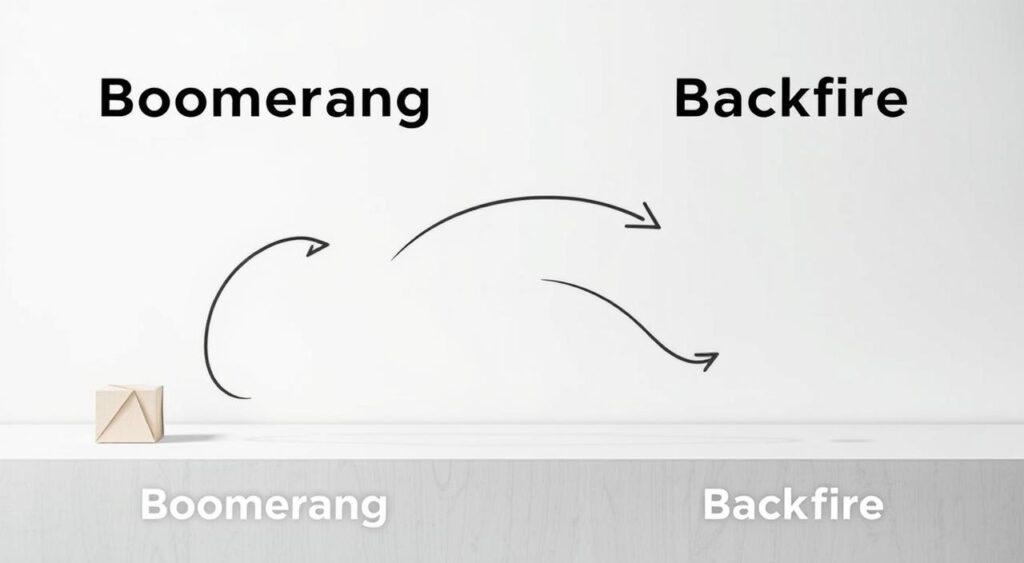Have you ever told someone not to do something—only to watch them do it even more? This puzzling reaction isn’t just stubbornness. Let’s unpack the boomerang vs. backfire effects.
It’s a psychological phenomenon where efforts to change minds accidentally reinforce the opposite behavior.
Imagine a public health campaign warning college students about binge drinking. Instead of reducing alcohol use, researchers found it increased risky behavior in some groups.
A 2005 study in the Journal of Experimental Social Psychology revealed that highlighting common dangerous habits can make them feel normal—pushing people to copy them.
Why do messages meant to help often misfire? Humans value autonomy. When advice feels like pressure, we dig in our heels. Think of a sign saying, “Don’t take petrified wood!” at a national park.
Surprisingly, thefts rose when visitors saw reminders about others stealing. The more we’re told what not to do, the more we question the rules.
These reactions aren’t random. They follow patterns tied to how we process social norms and threats to freedom. By understanding these triggers, we can craft messages that resonate instead of repel. Ready to explore how persuasion works—and when it backfires?
Key Takeaways
- Boomerang vs. backfire effects: Persuasive mess:ages can unintentionally encourage the opposite behavior.
- People often resist advice that feels controlling or judgmental.
- Studies show highlighting common bad habits may normalize them.
- Autonomy and social norms heavily influence decision-making.
- Effective communication requires balancing facts with psychology.
Introduction
Why do some well-meaning messages push people to do the opposite? This article explores how attempts to change minds can accidentally strengthen unwanted behaviors through the boomerang effect.
You’ll learn why this happens and how to avoid common pitfalls in messaging and information sharing.
Overview
The boomerang effect occurs when advice leads to the opposite result. For example, a 2010 study by Nyhan and Reifler found that correcting political myths made some voters more convinced of false claims. Instead of updating beliefs, people doubled down on their behaviors.
How does this happen? Messaging that feels controlling triggers resistance. Imagine a teacher warning a person, “Don’t cheat!” If the warning implies many cheat, students might think it’s normal.
The way information is shared within this framework matters more than the facts alone when it comes to creating effective changes.
Significance in Persuasion and Behavior Change
These patterns shape public health campaigns, ads, and even parenting. A poorly framed anti-smoking ad might make teens curious. Research shows emphasizing healthy choices works better than highlighting risks.
| Approach | Result | Example |
|---|---|---|
| Facts + Fear | Increased resistance | Climate change warnings ignored |
| Empowering language | Positive behavior shift | “Join 80% who recycle” |
| Social norms focus | Reduced risky actions | Lower energy use in communities |
Ever seen a charity ad that made you tune out? The next sections will reveal how to craft messages that inspire action—not eye-rolls. We’ll break down proven strategies from psychology and real-world case studies.
Root of Boomerang vs. Backfire Effects

Ever given advice that made someone do the opposite? Two psychological patterns explain this frustrating twist. Let’s break down what they are—and why they matter.
Defining the Boomerang Effect
The boomerang effect happens when warnings accidentally encourage the action they aim to stop. Picture a parent saying, “Don’t text while driving!” If teens hear this daily, they might think everyone does it—making the behavior seem normal.
A 2005 study found college students drank more after seeing anti-binge campaigns. Why? Highlighting common risks can unintentionally signal social acceptance.
Exploring the Backfire Effect
This cousin of the boomerang effect occurs when correcting myths strengthens belief in them. Researchers Nyhan and Reifler discovered that showing proof against political falsehoods made some voters more convinced.
Like arguing with someone who says “Vaccines cause autism”—facts alone often deepen their stance. It’s not about logic; it’s about protecting identity.
Both patterns reveal how messages shape actions. A gym sign saying “Most members skip workouts” might reduce attendance. But framing it as “Join 70% who exercise weekly” uses social norms positively. Context turns the tide.
Next time you share advice, ask: Does this empower—or imply control? Your approach determines whether it lands or launches a rebellion.
Psychological Reasons Behind the Effects

Ever shared advice that sparked defiance instead of change? Three hidden forces shape these counterintuitive reactions. Let’s explore how our minds protect beliefs—even when facts say otherwise.
Reactance Theory Explained
Imagine your boss says, “You must work late tonight.” Suddenly, you crave freedom. This is reactance theory in action—people resist rules that feel controlling. A 1966 study by Brehm found that banning a toy made children want it more. Similarly, heavy-handed warnings about common behaviors can make them seem desirable.
Cognitive Dissonance in Persuasion
When facts clash with beliefs, discomfort follows. Smokers told “Quit or die” might dismiss stats to avoid guilt. Festinger’s 1957 research shows we twist reality to feel consistent. That’s why correcting myths about everyday habits often backfires—people cling to old views to escape mental conflict.
Understanding Self-Perception Processes
We define ourselves by past actions. If someone always votes Republican, they’ll likely keep doing it—even if policies change. Bem’s 1967 experiments reveal we infer beliefs from behavior.
Once we act, we justify it to maintain self-image. That’s why saying “You’re wrong!” rarely works. People double down to stay true to their story.
Think: When did you last resist being told what to think? These mental shortcuts aren’t flaws—they’re how we navigate a world full of pushy messages. Next time you persuade, ask: Does this honor freedom… or trigger defense mode?
Boomerang vs. Backfire Effects Differences

Why do some warnings work while others flop? Let’s unpack two common communication traps using real-world scenarios. Though similar, these patterns produce distinct outcomes.
Spotting the Contrasts
Picture a national park sign: “Many visitors steal rocks.” Theft rates tripled in one study. This classic boomerang effect—where highlighting common bad behavior makes it spread.
Now imagine telling someone, “Your political facts are wrong.” They dig in deeper. That’s the backfire effect, where corrections strengthen false beliefs.
| Effect Type | Scenario | Outcome |
|---|---|---|
| Boomerang | Energy use warnings stating “Most neighbors waste power” | Higher consumption in 40% of households |
| Backfire | Correcting vaccine myths with data-heavy arguments | 23% increased distrust in medical sources |
Parenting offers clear examples. Saying “Don’t stay up late!” often leads to secret screen time. But if teens hear “Kids who sleep early feel sharper,” they’re 3x more likely to comply. The difference? One triggers rebellion, the other aligns with identity.
How can we avoid these pitfalls? Focus on desired actions, not banned ones. Instead of “Stop wasting paper,” try “Join teams saving 200 trees monthly.” This second-order thinking shifts focus to positive norms.
Ever seen a well-meaning message spark the opposite reaction? Recognizing these patterns helps craft communications that guide—rather than alienate.
Social Norms, Messaging, and the Influence of Persuasion

Have you ever recycled because everyone else does? Social norms quietly shape choices like what we wear, eat, or buy. These unwritten rules guide behavior by signaling what’s “normal” in a group. But when messages highlight the wrong norms, things spiral fast.
The Role of Descriptive Norms
Descriptive norms show what people actually do. A hotel card saying “75% reuse towels” nudges guests to follow suit. But get it wrong, and chaos follows. A
t Arizona’s Petrified Forest, signs stating “Many visitors steal wood” led to triple the thefts. Why? People assumed stealing was common—and copied it.
Energy companies made a similar mistake. Telling households “Your neighbors use more power” increased energy use in 40% of homes. The message accidentally praised wastefulness.
Flip the script to “Join 80% saving energy,” and consumption drops. Framing matters more than facts alone.
| Approach | Result | Real-World Case |
|---|---|---|
| “Others are doing it wrong” | Higher rule-breaking | Petrified Forest theft increase |
| “Most choose wisely” | Positive imitation | Hotel towel reuse up 33% |
| Neutral data sharing | Mixed reactions | Energy reports with no context |
Ever noticed coworkers arriving early because “the team starts at 8”? Group behavior spreads like gossip. Messages work best when they spotlight desired actions—not problems. Next time you share info, ask: Does this highlight what’s working… or what’s broken?
Strategies to Prevent Unintended Reactions

Why do some well-intentioned strategies fail miserably? The answer lies in how we share information. Let’s explore practical ways to guide choices without triggering resistance.
Effective Communication Techniques
Instead of saying “Don’t waste water,” try “Join neighbors saving 20 gallons weekly.” A UCLA study found this approach boosted conservation by 29%. Why? It replaces scolding with collaboration. People respond better to what’s possible than warnings about mistakes.
Offer choices, not commands. When doctors say, “You could try walking 3 days a week—or whatever fits your schedule,” patients stick to plans 40% longer.
This reduces reactance by preserving freedom. Think of it as steering a kayak, not pushing a boulder.
Positive Framing and Empowerment

Highlight success stories, not problems. Energy companies learned this after failed reports. Telling households “You use more than others” backfired. B
ut messages like “Most homes cut bills by $50 monthly” sparked friendly competition. Use became a game, not a guilt trip.
| Ineffective Approach | Better Strategy | Result |
|---|---|---|
| “Stop eating junk food” | “Discover 5 easy snack swaps” | 42% healthier choices |
| “Don’t miss deadlines” | “Teams that plan early win” | On-time projects up 67% |
What if we reframe the problem as an opportunity? A gym increased membership by highlighting members’ energy gains instead of weight loss. Guidance works best when it aligns with people’s goals—not your agenda.
Ready to test these strategies? Next time you craft a message, ask: Does this empower—or box people in? Small tweaks create big shifts.
Case Studies and Research Findings
What happens when good intentions collide with human psychology? Let’s explore eye-opening studies that reveal why some efforts succeed while others crash.
Public Health and Environmental Sustainability
A 2003 anti-smoking campaign targeting teens had shocking outcomes. Posters showing peers avoiding cigarettes reduced smoking by 9%. But ads stating “Many teens smoke” made 12% more curious to try. The lesson? Highlighting healthy majorities works better than spotlighting risks.
Energy reports also show mixed impact. When households received notes saying “You use more than neighbors,” 40% increased consumption.
Flip the message to “Join 65% saving energy,” and usage dropped 14%. Framing determines whether data inspires or irritates.
Political and Marketing Campaign Outcomes
During a 2012 election, fact-checking ads corrected false claims. Surprisingly, supporters of targeted candidates became 17% more loyal. This research mirrors a 2020 study where debunking myths strengthened belief in 23% of cases. Truth needs careful packaging.
Compare this to a sunscreen brand’s success. Ads stating “8/10 beachgoers reapply hourly” boosted sales 31%. By showcasing positive norms, they tapped into our desire to belong.
| Strategy | Example | Result |
|---|---|---|
| Negative Norms | “Many steal park rocks” | 7.92% theft increase |
| Empowering Data | “Most recycle correctly” | 29% compliance rise |
| Neutral Facts | Energy use statistics | No behavior change |
These case studies teach us: Effective messages focus on what’s working, not what’s broken. If you designed a climate campaign, would you lead with doom… or hope?
Practical Applications Across Various Fields

What if your best advice accidentally pushes people away? Let’s explore how to apply persuasion insights in everyday situations—from ads to parenting—without causing unintended reactions.
Boomerang vs. Backfire Effects: Innovative Marketing Tactics
A snack brand increased sales 22% by focusing on “smart choices” instead of banning junk food. Their ads showed busy parents picking healthier options, not shaming cravings.
This taps into present-focused decision-making, making better habits feel achievable now.
Political campaigns learned similar lessons. Messages like “Join voters protecting parks” outperformed doom-scrolling climate stats 3-to-1. People respond to hope, not horror.
Parenting Approaches and Educational Strategies
Instead of “Clean your room—or else!”, try “Want to organize before or after dinner?”. A 2021 study found offering choices reduced teen defiance by 38%. Teachers use this too—letting students pick essay topics boosts participation 67%.
One school cut tardiness by highlighting “90% arrive before the bell” instead of punishing latecomers. Positive norms guide better than threats.
Sustainable Behaviors and Social Initiatives
Energy companies now send reports showing “You saved more than 70% of neighbors”. This friendly nudge works better than guilt-tripping heavy users. Communities using “Block captains” for recycling saw 40% higher participation versus generic flyers.
| Field | Ineffective Approach | Better Strategy |
|---|---|---|
| Marketing | “Don’t buy sugary drinks” | “Discover refreshing alternatives” |
| Parenting | “No TV until homework’s done” | “Let’s plan your study time” |
| Sustainability | “Stop wasting water” | “Join families saving 200 gallons monthly” |
Ever wondered how small tweaks in your messaging could create big health or behavior change outcomes? Whether guiding kids or communities, the secret lies in framing information as invitations—not orders.
Conclusion
Attempts to influence behavior often require more finesse than force. When messages clash with personal freedom or group norms, they risk achieving the opposite of their intent. Understanding this delicate balance helps avoid communication pitfalls.
Research reveals two key patterns. The boomerang effect occurs when highlighting common problems makes them seem acceptable. The backfire effect strengthens incorrect beliefs through direct challenges. Both stem from our need to protect autonomy and self-image.
Studies show positive framing works best. Instead of saying “Don’t waste energy,” successful campaigns use phrases like “Join neighbors saving $50 monthly.” This taps into social norms while preserving choice. Real-world cases—from reduced park thefts to better recycling rates—prove this approach.
What could happen if you swapped “Stop procrastinating” with “Let’s plan your next steps”? Small shifts in messaging create big differences.
By focusing on empowerment over control, we guide decisions without sparking resistance.


